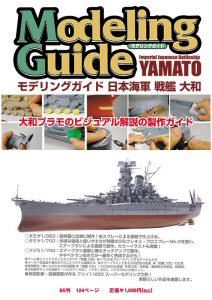| Model Art Co., Ltd, Tokyo, Japan |
| Modeling Guide for IJN Yamato Battleship |
| Reviewed By Luke R. Bucci, PhD, IPMS# 33549 |

|
|
MSRP: 1800 yen (approximately $20)
Pages: 128; Pictures: over 700, mostly color; Diagrams: over two dozen; Foldouts: 3 in 1:500 scales Modeling Guide's Model Art No. 708 focused on building several kits of the World War 2 Japanese super-battleship Yamato. Yamato, and her sister ship Musashi, were the largest (heaviest) battleships completed, and were considered to be virtually impregnable. They were the pride of the Imperial Japanese Navy. Both succumbed to massive carrier-borne air attacks in the Battle of the Sibuyan Sea in 1944 (Musashi) and off Okinawa in 1945 (Yamato). Because of its status and mystique as the world's largest battleship, the Yamato is one of the most widely modeled warships. Model Art No. 708 provides the best how-to-build guide yet for the Yamato, in a soft-bound book of approximately 7 x 10 inches. Text is almost entirely in Japanese, but this is not a hindrance. Binding is tight, meaning years of repetitive use will not destroy the spine. Paper quality is very high, and photographs are printed to a very high degree of quality on glossy stock. Photographs are crisp, in-focus, and framed well. The overall quality of this publication is top-notch & first-class - it cannot be any better (except maybe a larger size). Sixteen articles describe in-depth coverage of building models of Yamato in several scales, along with excellent and detailed reference diagrams of configurations over time for each ship. Thus, with this book, a historically accurate version of Yamato and Musashi at any time period of their existence can be modeled. The sixteen articles are as follows: 1. 1:700 scale Tamiya 113 kit build, out-of-box (pages 4-17) 2. 1:700 scale Japanese brand kit build, out-of-box (pages 18-23) 3. 1:350 scale Tamiya kit build, out-of-box (pages 24-49) 4. 1:450 scale Hasegawa kit, 1:600 scale Nichimo kit, 30cm scale Nichimo kit pictures of finished models with featured paints (pages 50-53) 5. Forced perspective box view conversion (as if observer was standing on bow looking aft) 6. 1:500 scale foldout drawings (as commissioned, 1944, 1945 final disposition with a photo of 1:250 scale model) (pages 57-72, but not numbered) 7. 1:250 scale model build tips with mostly pictures of finished model (cutaways) (pages 73-83) 8. 1:700 kit superdetailing (pages 84-93) 9. 1:350 detailing (pages 94-95) 10. 1:700 scale model cut into sections showing interior (pages 96-97) 11. 1:144 scale finished model (page 98) 12. Detail sets (photoetch, brass gun barrels, etc.) (page 99) 13. Color diagrams of superstructure and gun arrangements showing every evolution of armament changes amidships for Yamato and Musashi (pages 100-109) 14. Text in Japanese - looks to me like an account of their operational career (pages 110-113) 15. 1:10 scale finished model pictures (yes, a model in 1:10 scale - in a hangar) (pages 114-119) 16. Advertisements (pages 120-127) Articles 1, 2, and 3 give exceptionally detailed, in-depth, step-by-step, how-to guides for building Yamato kits in 1:700 and 1:350 scales (the most common scales available). All tools, paints, accessories, materials and disposables are pictured in photographs and/or clear illustrations. Every step needed to expertly build each kit is provided. There is no need to translate the accompanying text, as the pictures are incredibly detailed and well-thought no matter what their size is. The detail is so explicit it even shows exactly how to take parts off of sprues, clean up each part, prep parts for assembly or painting, mask for airbrushing and glue tricky pieces. The sequence of building is excellent, and can be followed exactly without any problems. Plenty of photographs of the finished kits, even close-ups, show off the handiwork. The articles on detailing Yamato kits, along with the foldout diagrams and depictions of armament, greatly enable a modeler to build any version of the Yamato in any scale. The extensive kit build guides are for OOB (out-of-box) models, which is helpful for those who simply want to build the best kit possible without anything extra but paint. For those who want to add superdetails, rigging and other additions, that information is also presented. One tip for those who do not read kanji: from your Yamato or Musashi kit (they are almost all from Japan anyway), you can identify the symbols used for the names Yamato and Musashi, so you can easily determine which illustrations belong to which ship (this is helpful for the excellent illustrations on pages 100-109). This book is mandatory as a reference for accurately and expertly building any scale model of the Yamato or Musashi. This book also serves as an educational resource for building scale warships. The techniques illustrated are useful for any kit, and can help any modeler build better kits. This book is well worth the cost, and the time to track it down (www.modelart.jp would be one place to start). Lack of English text is irrelevant with the quality of this book. |
|
Information, images, and all other items placed electronically on this site are the intellectual property of IPMS/USA ®. |